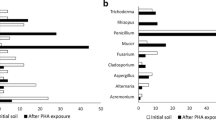Abstract.
The contribution of fungi to the microbial degradation of poly(3-hydroxybutyrate-co-3-hydroxyvalerate) (PHBV) films in soil was studied. Various traces, cavities, and grooves observed on the dented surface of PHBV films demonstrated that the degradation was a concerted effect of a microbial consortium colonizing the film surface, including fungi, bacteria, and actinomycetes. The succession of microbial consortia in the soil around the PHBV films during the degradation showed a distinctive increase in the fungal population, resulting in its dominance. Comparison of the degradation ability of microbial strains isolated from soil where PHBV films were degraded, revealed that fungi showed the highest contribution to PHBV degradation, growing very rapidly along the film surface with their high degradation ability and then expanding their hyphae in a three-dimensional manner.
Similar content being viewed by others
Author information
Authors and Affiliations
Additional information
Electronic Publication
Rights and permissions
About this article
Cite this article
Sang, .BI., Hori, .K., Tanji, .Y. et al. Fungal contribution to in situ biodegradation of poly(3-hydroxybutyrate-co-3-hydroxyvalerate) film in soil. Appl Microbiol Biotechnol 58, 241–247 (2002). https://doi.org/10.1007/s00253-001-0884-5
Received:
Revised:
Accepted:
Issue Date:
DOI: https://doi.org/10.1007/s00253-001-0884-5




